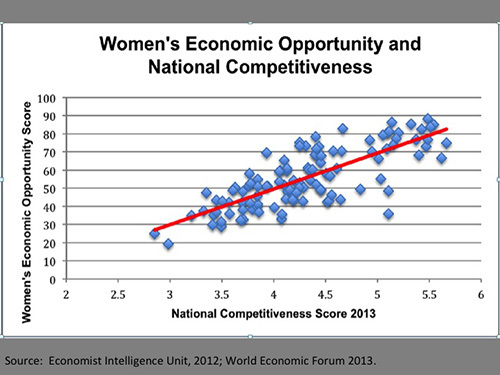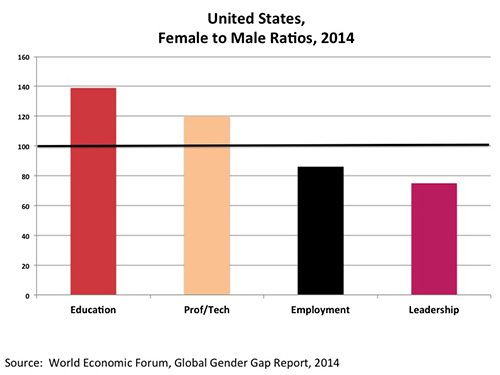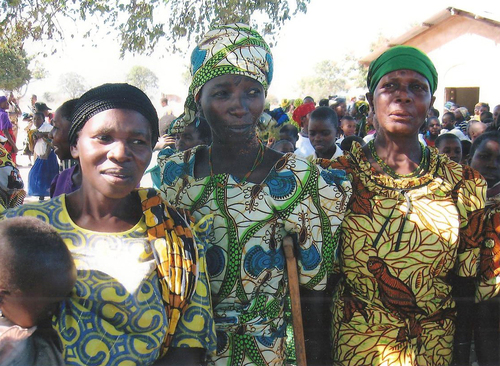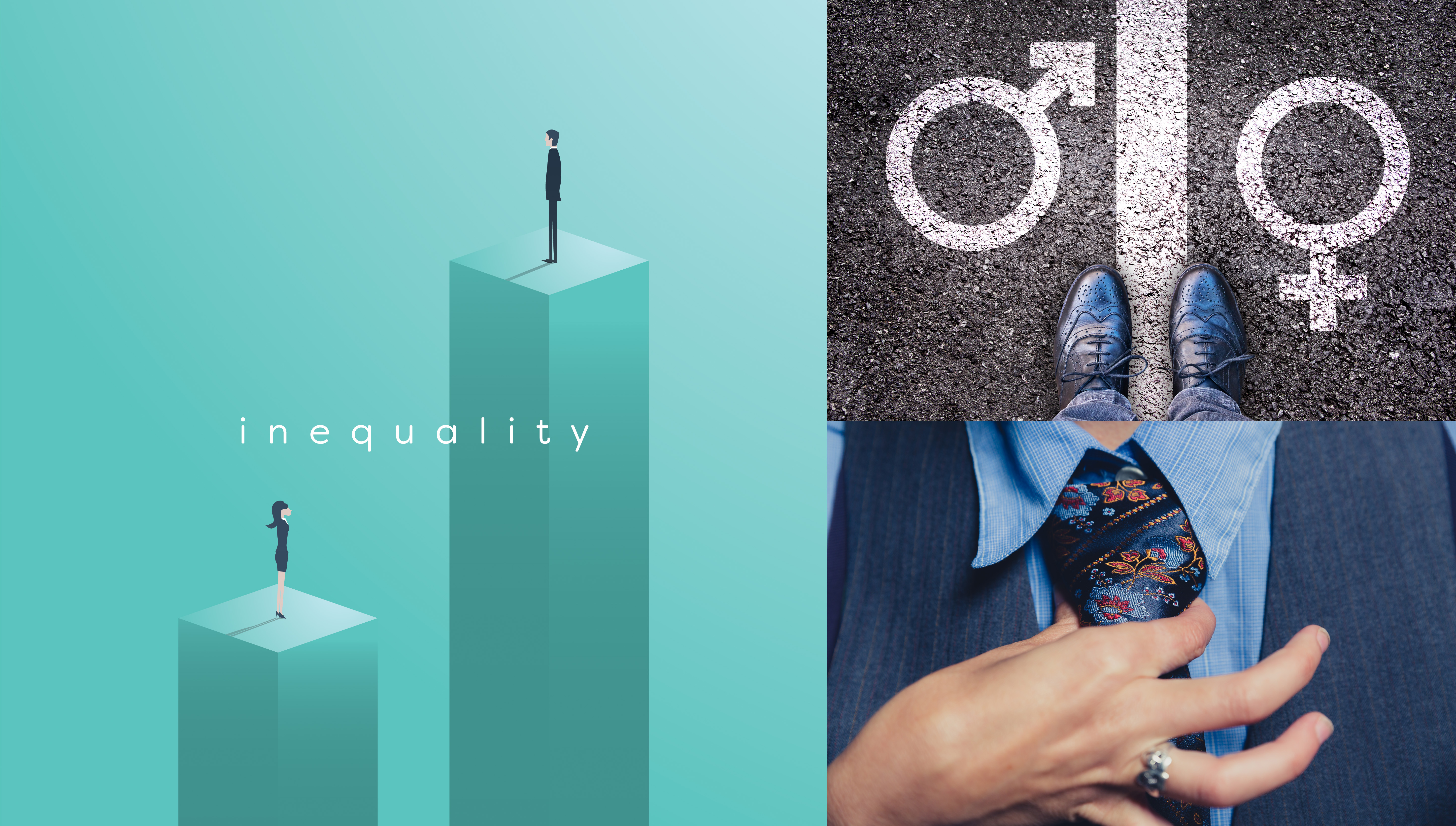
Goal 5 of the UN’s new Sustainable Development Goals is to achieve gender equality and empower all women and girls. Gender equality is the key to economic growth.
Linda Scott is DP World Chair for Entrepreneurship and Innovation at Saïd Business School, University of Oxford. Linda is best known for her creation of the concept of the Double X Economy – a perspective which describes the global economy of women in both the developed and developing world, and the roles of women not only as consumers, but as investors, donors and workers. She writes a blog called “The Double X Economy” and also blogs for Forbes and Bloomberg Businessweek on gender issues. In this interview for The Global Search for Education, I ask her about her research and concern for gender equality. Her thorough analysis of the global situation makes it clear that gender inequality is not only cruel but also economically disadvantageous. In our interview, Linda shares her tips for what educators and parents can do to combat gender inequality.
Linda, you argue that gender equality is key to economic growth. How do people respond to this idea? Is there a lot of pushback?
Actually, no, I do not get much pushback on this issue. Sometimes I have to explain to people why gender equality contributes to growth and prosperity. Once it is explained to them, most people accept it.

What are some real world examples of gender equality benefiting the economy?
There are four main ways in which gender equality contributes to growth. The first is simply the increase in the number of people who are economically engaged, whether as workers or business owners. A significant proportion of the economic growth experienced in the US and in Europe during the 20th century was caused by the entry of women into the labor force. The second is the improved efficiency in resource use. Today, there are more women in higher education than men, both in Europe and the US. If these women do not find employment or are held back by prejudice, the investment in their education will be lost. National competitiveness is all about efficient use of resources, so this instance of gender inequality directly affects a country’s performance. The third factor, a huge one, is avoiding the costs of gender inequality. In the parts of the world where gender inequality is highest, adolescent fertility is a major indicator of the subordinate status of women. It is well known that adolescent fertility is tied, as both cause and effect, to other phenomena that directly contribute to poverty, such as high infant and maternal mortality or early marriage. So, reducing adolescent fertility means giving girls a future – but the knock-on effects for the entire community are massively positive.
What are the top 10 things you’ve learned about gender equality from the global data you’ve analyzed?
- The gender gap is everywhere.
- The gender gap is real and measureable. It is not a hoax or a figment of some feminist’s imagination.
- Gender inequality retards economic growth.
- Gender inequality perpetuates poverty.
- Gender inequality is bad for families.
- Closing the gender gap will improve health in communities, for everyone.
- Bringing teenage girls into equality is the single most impactful thing you can do to help an economy.
- Women are paid less than men for the same work, even in countries where it has been illegal to do that for 50 years.
- Gender inequality fuels social instability, crime, and local conflict.
- Women’s subordination is substantially enforced by their exclusion from the money system.

Why do you think it might be that some people continue to foster models of gender inequality?
I think opponents of gender inequality fall into two camps. The first group has no knowledge of the facts that have been revealed about the extent of the gender gap and the damage it causes. We are living in the light of global data that we did not have fifteen years ago. But many people are simply not aware of this information. They look around and see that some women they know seem to be getting along fine and they deduce from these personal observations that there is no problem. But, in truth, we know now that there is a real, global-scale problem and it is a big one.
The second group wants no knowledge of the facts because they are fearful of gender equality and made angry by the very suggestion that we should close the gender gap. These are people who may or may not be ignorant, but they are extremely insecure and often have very negative attitudes toward women in general. They benefit in some way from the continuation of women’s subordination, so they are opposed to it.
What innovations could be scaled globally to create a positive outcome to this global problem?
A reporting system for equal pay that would hold employers accountable to disclose and redress gender imbalances would go a long way toward solving many gender problems in the workplace. IMF says better and fairer inclusion of women in the labor force would contribute significantly to growth in every country. Reform of the financial system is desperately needed to remove gender bias. IFC and Goldman Sachs report that closing the gender gap in credit, which they estimate to be nearly $300 billion, would help households and national economies to thrive.

What countries are making great progress on this front? What can we learn from them?
In the past, the Scandinavian countries made some policy decisions about gender equality and support for families that have now put them in the top ranks of all nations for gender friendliness. These countries are by no means perfect, but they have been innovative and successful on this front. Norway deserves special recognition for taking leadership on corporate board quotas. The United States actually performs very well, in spite of their lack of maternity leave. I think critics tend to overlook two very important innovations that helped the US on the road to equality: affirmative action and the class action lawsuit. Today, many African nations are legislating quotas for fair representation in governments and other organizations. A generation from now, we may see big change as the result.
Can the K-12 classroom be a place to change gender inequality? If so, what are some of the tools and curricula that teachers can work with to progress? What are some “technologies of inclusion” as you call them?
One of the most effective “technologies of inclusion” is sanitary pads. In many countries around the world, girls miss school during their periods because they do not have protection. When a girl doesn’t have a discreet way of managing her period (meaning disposable pads and not cloth), it is hard to keep her menstruation private, which leaves a girl open to rape or early marriage. That puts an end to her education.
Here are Six Tips for what educators and parents can do to combat gender inequality:
- Be humbly aware that most people have unconscious gender biases. These tend to show up in schools in the form of girls being called on less often, being praised less often, getting less of teachers’ time and attention. Try to correct for these by asking others to observe you in the classroom and give candid feedback.
- Try to avoid criticizing or punishing a girl simply for acting or speaking in a way thought more appropriate for a boy. In most cultures, for instance, girls are not supposed to speak out or interrupt. Boys are allowed, even encouraged, to do both. Both sexes need to learn to speak for themselves, but to allow others to speak as well.
- Choose teaching materials with an eye to balancing for gender. Be sure, for instance, that fictional or historical works assigned have female, as well as male, protagonists. Girls need to read about heroines; boys need to learn to imagine themselves in the shoes of others who are not like them.
- Encourage girls to develop their own talents. This means encouraging them to excel in subjects usually thought to be best for boys (like math or sports), if they wish to do so. However, it does not mean pushing them into math and sports when their real passion is for art or writing. Let it be ok for girls to choose their own paths. Encourage excellence in all fields.
- Do not allow boys to bully or ridicule girls in a mean way. The girls have a right to their dignity when attending school; the boys have a right to learn civility.
- Be mindful of the painful experiences that puberty can bring to children. Girls, in particular, experience a great deal of self-consciousness about puberty, since they are much more likely to have visible signs, such as breasts, or embarrassing revelations, such as a menstrual accident. Make sure your school has appropriate facilities and an environment that allows such natural changes to occur in safety.

(All Pictures are courtesy of Linda Scott and C M Rubin)
Join me and globally renowned thought leaders including Sir Michael Barber (UK), Dr. Michael Block (U.S.), Dr. Leon Botstein (U.S.), Professor Clay Christensen (U.S.), Dr. Linda Darling-Hammond (U.S.), Dr. MadhavChavan (India), Professor Michael Fullan (Canada), Professor Howard Gardner (U.S.), Professor Andy Hargreaves (U.S.), Professor Yvonne Hellman (The Netherlands), Professor Kristin Helstad (Norway), Jean Hendrickson (U.S.), Professor Rose Hipkins (New Zealand), Professor Cornelia Hoogland (Canada), Honourable Jeff Johnson (Canada), Mme. Chantal Kaufmann (Belgium), Dr. EijaKauppinen (Finland), State Secretary TapioKosunen (Finland), Professor Dominique Lafontaine (Belgium), Professor Hugh Lauder (UK), Lord Ken Macdonald (UK), Professor Geoff Masters (Australia), Professor Barry McGaw (Australia), Shiv Nadar (India), Professor R. Natarajan (India), Dr. Pak Tee Ng (Singapore), Dr. Denise Pope (US), Sridhar Rajagopalan (India), Dr. Diane Ravitch (U.S.), Richard Wilson Riley (U.S.), Sir Ken Robinson (UK), Professor Pasi Sahlberg (Finland), Professor Manabu Sato (Japan), Andreas Schleicher (PISA, OECD), Dr. Anthony Seldon (UK), Dr. David Shaffer (U.S.), Dr. Kirsten Sivesind (Norway), Chancellor Stephen Spahn (U.S.), Yves Theze (LyceeFrancais U.S.), Professor Charles Ungerleider (Canada), Professor Tony Wagner (U.S.), Sir David Watson (UK), Professor Dylan Wiliam (UK), Dr. Mark Wormald (UK), Professor Theo Wubbels (The Netherlands), Professor Michael Young (UK), and Professor Minxuan Zhang (China) as they explore the big picture education questions that all nations face today.
The Global Search for Education Community Page
C. M. Rubin is the author of two widely read online series for which she received a 2011 Upton Sinclair award, “The Global Search for Education” and “How Will We Read?” She is also the author of three bestselling books, including The Real Alice in Wonderland, is the publisher of CMRubinWorld, and is a Disruptor Foundation Fellow.
Follow C. M. Rubin on Twitter: www.twitter.com/@cmrubinworld






Recent Comments